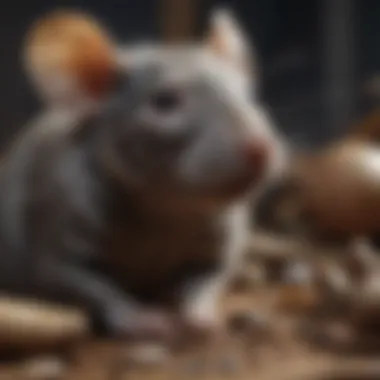Understanding Rats: Exploring Their Biology and Culture


Intro
Rats, often seen as pests, carry a rich tapestry of biological and behavioral traits that reflect their adaptability and intelligence. This article delves into the complex lives of these creatures, from their unique ecological roles to their misunderstood relationships with humans. Understanding rats goes beyond removing them from urban settings; it involves acknowledging their significance in various contexts, including science and culture.
Fascinating Facts About the Animal
Unique Characteristics
Rats are members of the rodent family, highly adaptable in diverse environments. Their most notable feature is their dentition. The incisors continuously grow throughout their lives, making gnawing essential for maintaining their teeth's length.
Subspecies such as the Brown rat (Rattus norvegicus) and Black rat (Rattus rattus) exhibit variations in size and fur color. They have long tails which help in balancing, and their large eyes aid in low-light vision. The size of a rat's brain relative to its body size suggests a higher intelligence compared to many other mammals.
Extraordinary Abilities
Rats possess remarkable cognitive skills. They can navigate complex mazes and solve problems to obtain food. Their sense of smell is highly developed, allowing them to detect scents over great distances. Moreover, they can receive sounds beyond the range of human hearing, using ultrasonic communication for social interactions and mating.
Behavior and Habitat
Natural Habitats
Rats thrive in diverse habitats, including urban areas, forests, and grasslands. Their ability to adapt to different environmental conditions makes them successful colonizers. Urban settings provide abundant food sources, while rural areas offer shelter and nesting sites.
Social Structures
Rats are social animals and tend to live in groups, called colonies. These colonies can include dozens of individuals. Within these groups, a hierarchy usually emerges. Dominance and submission behaviors play crucial roles in their interactions. They communicate through vocalizations, scent marking, and grooming behaviors, which strengthen their social bonds.
Recent Scientific Discoveries
Latest Research Findings
Studies have shown that rats can be trained to perform tasks and exhibit empathy towards other rats. Research indicates that they often display altruistic behavior, helping each other in times of distress. This challenges the long-standing perception of rats as solely self-interested creatures.
Breakthroughs in Animal Biology
Understanding the biological makeup of rats leads to insights into mammalian evolution. Research in genetics has revealed details about their reproduction and adaptability. Specific genes have been identified that contribute to their resilience in different environments, aiding scientists in further studies of genetics in other species.
Cultural Significance
Animals in Folklore
Rats appear in various cultural narratives around the world. In some cultures, they are revered as symbols of fertility or resourcefulness. In contrast, other traditions view them as omens of disease or misfortune. These differing perspectives highlight the complex views humans have towards rats.
Influence on Art and Literature
Rats have also found their place in art and literature. From the infamous
Preface to Rats
Rats often evoke mixed feelings. While they have a notorious reputation as pests, there is much more to understand about these complex creatures. This section aims to provide a foundational understanding of rats. Examining their definitions and classifications unveils the diversity and ecological significance of these rodents. Comprehending the essence of what constitutes a rat is vital. It not only shapes our perception but also informs our interaction with them, whether in research or everyday life.
Defining Rats


Rats belong to the genus Rattus, which includes several species. The two most recognized types are the brown rat (Rattus norvegicus) and the black rat (Rattus rattus). These species differ in behavior, habitat preferences, and even physical traits. Brown rats are typically larger and are often found in urban environments. In contrast, black rats prefer warmer climates and are frequently found in rural areas. Defining what a rat is extends beyond mere taxonomy; it involves understanding their role within ecosystems, their behaviors, and their interactions with human beings.
Taxonomy and Classification
Rats are classified as mammals, specifically belonging to the family Muridae. This family comprises over 700 species, making it one of the largest families of mammals. Within this family, rats are distinguished from other rodents by unique anatomical and behavioral characteristics. The classification of rats is crucial for various scientific fields, including ecology and evolutionary biology. It sheds light on their evolutionary history and ecological roles. Furthermore, understanding their taxonomy can assist in differentiating between species that might impact agriculture, public health, or biodiversity.
Understanding the taxonomy of rats is essential for effective pest management and ensures accurate communication in scientific research.
Recognizing the diversity among rats brings awareness to their varied impacts on both the environment and human societies. A nuanced grasp of these elements enriches discussions about rats, facilitating a more informed viewpoint that goes beyond stereotypes.
Physical Characteristics of Rats
Understanding the physical characteristics of rats is crucial for a comprehensive exploration of these creatures. Their size, distinctive features, and color variations directly influence their behavior, habitat preferences, and interactions with humans and other wildlife. This section sheds light on how their physical traits serve functional purposes in their survival and ecological roles.
Size and Weight Variations
Rats exhibit a wide range of sizes and weights, which can vary significantly according to species and environmental factors. Typically, a common rat, such as the brown rat (Rattus norvegicus), weighs between 150 and 300 grams, while the larger black rat (Rattus rattus) may weigh around 100 to 500 grams. Size variations can be attributed to genetic factors, availability of food sources, and habitat conditions.
The significance of understanding size and weight variations lies in their implications for survival strategies. Larger rats tend to have fewer natural predators and may occupy different ecological niches than their smaller counterparts. Moreover, the size influences their breeding habits, social structures, and even disease dynamics. Larger populations may lead to increased competition for resources, which then affects the overall health of rat communities.
Rats are adaptable creatures. Notably, changes in their size or weight can indicate shifts in environmental conditions or population density.
Distinctive Features
Rats possess a number of distinctive features that set them apart from other rodents. One of their most notable characteristics is their long, scaly tail. This tail helps in balance and thermoregulation, allowing rats to navigate their environments effectively. Additionally, their whiskers are highly sensitive, aiding in spatial awareness and navigation in low-light conditions.
Ears and eyes also play important roles in rat communication and interaction with their environment. The prominent ears can detect a wide range of frequencies, and their acute sense of hearing allows them to recognize the sounds of predators or other rats. Understanding these features provides insights into their behavior patterns, as rats are highly social animals that rely on vocalizations and tactile interactions.
Color Variations
Rats come in a variety of colors, which can also have ecological and social implications. Common colors include brown, gray, and black, but some species exhibit albino variations or other unique color patterns. The color of a rat's fur can influence its camouflage in different environments, helping it to avoid predators.
Moreover, certain colors may affect social dynamics among rat populations. For instance, color variations could play a role in mate selection and group cohesion. By studying color traits, researchers can gain valuable information about the adaptability of rats in urban versus rural settings, where environmental pressures can differ drastically.
In summary, the physical characteristics of rats—size and weight variations, distinctive features, and color variations—are pivotal for understanding their behaviors and ecological roles. This knowledge is critical not only for scientists and wildlife biologists but also for families who may encounter these creatures in their everyday lives.
Behavioral Traits of Rats
Understanding the behavioral traits of rats is vital to comprehending their roles within ecosystems and their interactions with humans. Rats exhibit a range of behaviors that reveal their social structures, communication styles, and cognitive abilities. By studying these traits, researchers can gain insights into their adaptability and resilience, which can inform management practices and improve human-rat relationships.
Social Structure and Hierarchy
Rats have complex social structures that depend on their environment and the availability of resources. Typically, they establish hierarchies, influenced by factors such as age, size, and reproductive status. Higher-ranking individuals may gain priority access to food and mates, which can impact the survival and reproduction of the group.
Observations in both wild and domesticated rat populations show they often engage in cooperative behaviors, including grooming and nest building. Such behaviors foster strong social bonds and create a sense of community. These social traits are essential for survival, as they enhance group cohesion and provide protection against predators.
Rats also display territorial behavior. Males are often more territorial, establishing boundaries with scent markings to communicate their presence to others. This behavior is crucial, as it minimizes conflicts over resources but can lead to aggressive interactions with other males.
Communication Methods
Rats utilize a variety of communication methods to convey information. They rely on vocalizations, body language, and scent marking. Vocalizations can include squeaks, chirps, and even ultrasonic calls, which are inaudible to humans. These sounds can indicate distress, social excitement, or mating calls.


“Rats have an intricate communication system, allowing them to convey their needs and emotions effectively.”
Scent marking also plays a significant role in communication. Rats use urine and gland secretions to mark their territory, which indicates their identity and reproductive status to others. This process is essential for maintaining social hierarchies within groups.
In addition, rats exhibit specific behaviors when interacting with one another. For example, they may exhibit play behavior, which is vital for developing social skills and strengthening bonds within their communities. These interactions indicate a sophisticated level of social awareness and adaptability.
Cognitive Abilities
The cognitive abilities of rats are remarkable. Studies have shown that they are capable of complex problem-solving and learning tasks. Their intelligence allows them to navigate intricate environments and adapt to various challenges. For instance, they can remember the layout of mazes and figure out how to obtain food rewards.
Rats can also learn from each other, a trait known as social learning. When one rat discovers a successful method of obtaining food, others may observe and mimic this behavior. This ability to learn from peers enhances their survival skills and allows them to thrive in diverse environments.
Moreover, researchers have found that rats have impressive memory capabilities, particularly in spatial tasks. They can remember locations of food sources and navigate back to them even after long periods. This skill is beneficial for survival, especially in their search for resources in their habitats.
Ecological Importance of Rats
Understanding the ecological importance of rats offers insight into their role in natural environments and their interactions with other species. Despite their often negative reputation, rats fulfill various essential functions in ecosystems. Recognizing these contributions may alter the perception of rats as mere pests and instead appreciate their ecological significance.
Role in Ecosystems
Rats are integral to maintaining the balance within ecosystems. They serve as both prey and predator, affecting populations of other species. Here are several key points detailing their role:
- Nutrient Cycling: Rats contribute to nutrient cycling through the decomposition of organic material. Their gnawing behavior helps break down food waste and other forms of biomass, returning nutrients to the soil.
- Seed Dispersal: Certain species of rats, such as the black rat, engage in seed caching. They store seeds in various locations, which promotes plant diversity as seeds may germinate away from the parent plant.
- Food Source for Predators: Rats are a significant food source for many predators, including owls, hawks, and larger mammals. Their presence supports populations of these predators, thereby aiding in maintaining ecological balance.
Rats' adaptability allows them to thrive in diverse environments, thereby helping ecosystems evolve and stabilize.
Impact on Other Species
Rats' influence extends beyond their immediate surroundings. As active participants in their habitats, they impact various other species in numerous ways:
- Competition: Rats can compete with other small mammals and birds for food resources. Their ability to consume a wide range of foods gives them an advantage, which can lead to declines in populations of other species.
- Disease Transmission: While rats can carry diseases that affect humans and domestic animals, they also have implications for wildlife health. Certain pathogens may spread between species, complicating conservation efforts for endangered species.
- Ecosystem Engineers: By burrowing and creating tunnels, rats can alter their environments. These activities can benefit other species by creating habitats that support diverse life forms, such as insects and plants.
Rats are more than mere nuisances; their roles in ecosystems reflect a complex interaction with other organisms. Understanding these relationships is crucial for wildlife management and conservation strategies.
In summary, rats contribute significantly to ecological dynamics. Their roles involve nutrient cycling, seed dispersal, and providing sustenance for predators, showcasing their essential presence in the natural world.
In summary, rats demonstrate remarkable ecological importance from influencing food webs to impacting biodiversity. By shedding light on these aspects, we reinforce the understanding that these creatures are vital to maintaining ecological integrity.
Rats and Human Interaction
Rats have had a complex relationship with humans, which spans from deep-seated fear to reliance on these animals for scientific advancement. Understanding this interaction is crucial for comprehending not only the nature of rats but also the impact they have on society. Their presence in urban areas, as well as their role in scientific experiments and cultural contexts, shapes human perceptions and responses toward them.
Rats in Research
Rats are often used in scientific research due to their genetic, biological, and behavioral similarities to humans. This connection makes them a valuable model for studying human diseases, drug development, and psychological behavior. The benefits of using rats in research are multiple:
- Rapid reproduction cycle allows for extensive longitudinal studies within a short timeframe.
- Controlled breeding leads to genetic homogeneity, minimizing variables in experimental research.
- Their cognitive abilities provide insights into learning, memory, and decision-making processes.
The ethical concerns regarding the use of rats in research are significant and debated. Adhering to guidelines for humane treatment is critical. Researchers often strive to minimize suffering and find alternative methods when possible.
Pest Control and Management


Rats are often regarded as pests, especially in urban environments where they can cause significant damage to infrastructure and food supplies. Effective pest management strategies become essential for maintaining public health and safety related to rats. Several methods exist for control and management:
- Habitat modification can reduce rat populations by removing food, water, and nesting sites.
- Trapping is a practical approach that can be humane when executed correctly.
- Rodenticides are used but should be approached with caution due to potential non-target species impacts.
Community awareness is vital. Educating the public on effective management strategies helps to mitigate the negative impact of rats while also respecting their ecological roles.
Cultural Perceptions of Rats
Culturally, rats are often seen in dualistic perspectives. They can symbolize disease and filth in some contexts, while in other cultures, they represent intelligence and adaptability. Notable examples include:
- Literature and Film: From The Tale of Despereaux to Ratatouille, rats can be depicted as heroes or tragic characters, shaping public perception.
- Symbolism: In some cultures, rats are viewed as omens or symbols of change, offering insights into human fears and societal issues.
It is essential to recognize how cultural narratives surrounding rats affect human sentiment.
Rats may be viewed in contrasting lights based on these myths and stories. Understanding this duality offers a more nuanced perspective on the role of rats in human society, helping to foster respect and more informed decisions regarding their management and study.
Health Concerns Related to Rats
Understanding the health concerns related to rats is essential in addressing their interactions with humans and other species. Rats are known carriers of various diseases that can pose serious health risks, not only to individuals but also to public health on a broader scale. This section highlights key diseases transmitted by rats and provides practical prevention strategies.
Diseases Transmitted by Rats
Rats can be vectors for several infectious diseases. The following are some significant diseases associated with rats:
- Leptospirosis: This bacterial infection can be contracted through water or soil contaminated with rat urine. It can result in severe symptoms, affecting the liver and kidneys, and can be life-threatening if untreated.
- Hantavirus: Primarily spread through contact with rat droppings or urine, this virus can cause serious respiratory issues. In severe cases, hantavirus can lead to hantavirus pulmonary syndrome, which can be fatal.
- Salmonellosis: Rats can harbor Salmonella bacteria, which cause food poisoning in humans. This can occur when food or surfaces are contaminated with rat feces.
- Plague: Although often associated with fleas, rats can carry the bacteria Yersinia pestis. Humans can become infected through bites or direct handling of infected rats.
- Rat-Bite Fever: This illness can be caused by a bite or scratch from a rat. Symptoms can range from fever to painful swelling.
Rats in Popular Culture
Rats have a notable presence in popular culture, influencing literature, film, and other media forms. This aspect of rats is crucial as it reflects society's complex relationship with them. Understanding how rats are portrayed can help challenge misconceptions and foster a more nuanced perception of these creatures.
Rats in Literature and Film
In literature and film, rats often serve as symbols of various themes. Famous works such as *
The Future of Rats
Understanding the future of rats involves recognizing their ecological significance, as well as their relationship with humans. As urban environments expand, the interaction between humans and rats will continue to evolve. This new phase brings both opportunities and challenges that must be managed effectively.
Conservation efforts will play a key role in shaping the future of rat populations. This includes strategies that promote coexistence and management practices designed to minimize conflicts between rats and human populations. Recognizing their role in the ecosystem is vital for these strategies to be effective.
Advancements in research are also essential for the future of rats. Continued study into their behavior, genetics, and adaptability can help us understand these creatures better. The insights gained can inform management practices and highlight their ecological roles. Overall, understanding the future of rats will allow us to appreciate their complexities and mitigate potential issues.
Conservation and Management Efforts
Conservation of rat species, particularly in endangered habitats, is critical. Several aspects factor into successful conservation and management efforts, including:
- Habitat Preservation: Maintaining natural habitats is essential for biodiversity. Conserving ecosystems where rats thrive supports their populations while benefitting other species.
- Public Awareness Programs: Educating communities about the ecological roles of rats can foster a more balanced viewpoint. By addressing fears and misconceptions, these programs can promote acceptance and reduce conflict.
- Sustainable Management Practices: Adopting humane pest control methods can ensure that rat populations remain in check while minimizing harm. Utilizing methods like population monitoring or promotion of natural predators can balance the ecosystem.
By implementing these strategies, we can create a sustainable future for rat populations, ensuring their ecological roles are respected and protected.
Research Directions
Research plays a pivotal role in shaping our understanding of rats and their future. Several key areas of focus are important:
- Behavioral Studies: Further examination of rat social structures and communication methods can reveal their intelligence and adaptability. This knowledge can lead to improved management techniques and enhance our understanding of urban wildlife.
- Genetic Research: Investigating the genetic diversity among rat populations can highlight resilience against diseases and environmental changes. Understanding these genetic traits can aid in conservation efforts.
- Impact of Urbanization: Understanding how urban environments affect rat behavior and health is essential. Research on how rats adapt to these changes can inform urban planning and wildlife management.
These research directions are crucial for a holistic understanding of the future of rats and their interaction with the environment and humans. Ultimately, a thorough approach in these areas will enhance conservation efforts and foster a more informed public perspective.
“Understanding the complexities of rats provides an opportunity to appreciate their role in our ecosystems.”







